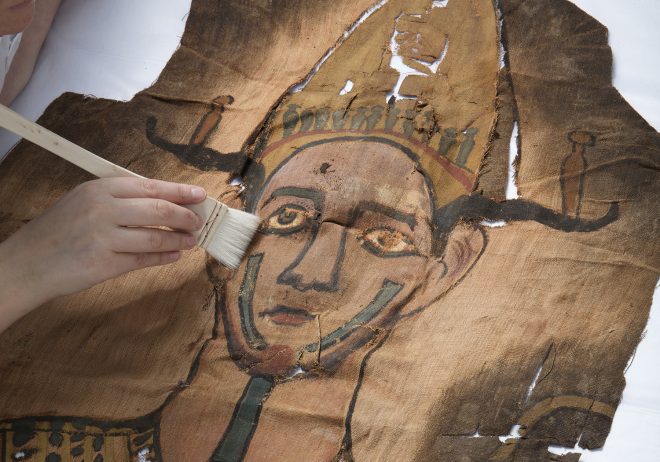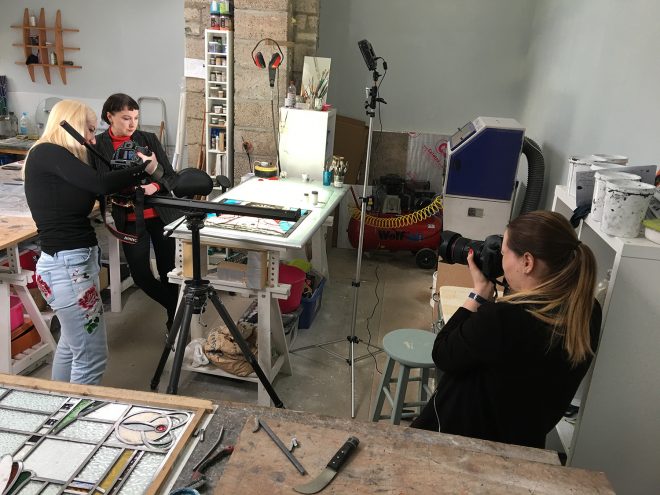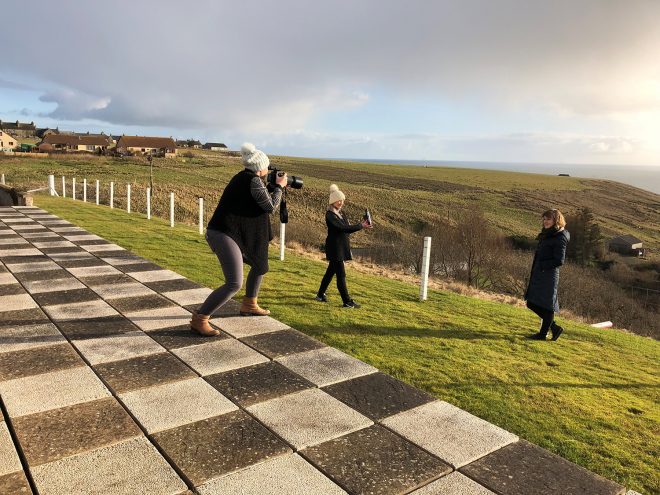From the earliest times in history to meeting modern pop stars, its been an exciting year in film production at National Museums Scotland. I’ve travelled the length and breadth of Scotland, battled icy conditions, unearthed precious silver hoards and reported live from within an ancient Egyptian tomb.
Inside an ancient Egyptian tomb
The journey began in ancient Egypt with The Tomb: Ancient Egyptian Burial. This free exhibition documented the history of a single tomb that was constructed in the great city of Thebes shortly after the reign of Tutankhamun for the Chief of Police and his wife.
The tomb was looted and reused several times, leaving behind a collection of beautiful objects from various eras. These were displayed alongside objects found in nearby tombs, giving a sense of how burial in ancient Egypt changed over time. The Tomb’s final use occurred shortly after the Roman conquest of Egypt when it was sealed intact with the remarkable burials of an entire family.

As my colleague, Hazel Saunderson has documented on this blog the Digital Media team has been using Facebook Live since 2016 to efficiently capture the views and expertise of curators from within our major exhibitions. As Facebook themselves state:
“Live is the best way to interact with viewers in real time. Field their burning questions, hear what’s on their mind and check out their Live Reactions to gauge how your broadcast is going.”
Whilst all this may be true and they provide some basic hints and tips, there are additional things to consider to make sure your live stream runs smoothly and your focus remains on the content, not your equipment. Here’s a simple checklist that we’ve developed over the last year or so:
Prior to filming
- Propose a date and time for the live stream
- Ask the presenter (in this case the curator) if they are available
- Fill out an operations sheet so that internal colleagues know what is happening
- Write an outline script and share with the presenter
- Ask at least assistance from a department colleague
- Take a walk around the space you’re filming in.
On the day of the live stream
- Organise your filming kit, make sure all equipment is charged and ready to use (lights, iPhone, tripod, headphones and microphone)
- Have an early rehearsal and practice video shoot
- Have another rehearsal just before going live
- Write captions ready for sharing
- Remove any squeaky shoes or clinking jewellery
- Check sound, lighting and shooting positions
- Countdown and start filming
- Get your colleague to respond to any engagement
- Once complete, save live video and later add subtitles, and share on YouTube.
Below is one of three live streams I directed from The Tomb exhibition with Dr Margaret Maitland, Senior Curator of Ancient Mediterranean collections at National Museums Scotland. In this clip she examines the mummy shroud of Aaemka, son of Montsuef and Tanuat (c.9BC-AD 10).
The Tomb Live: The ShroudJoin Dr Margaret Maitland, Senior Curator of the Ancient Mediterranean, examining the mummy shroud of Aaemka, son of Montsuef and Tanuat (c.9BC-AD 10).On the painted and dyed linen shroud, Aaemka is shown transformed into the god Osiris, ruler of the afterlife. He wears Osiris’ crown and false beard, and holds symbols of power, the crook and flail. Across his brow is a frieze of protective royal cobras. This rich symbolism was intended to help transform Aaemka into a semi-divine being to aid his transition into eternal life. The shroud is part of an intact burial of an entire Roman-era family, which marked the final period of use of a remarkable tomb in Thebes, Egypt. The Tomb was used and reused several times over a period of more than a 1,000 years, leaving behind a collection of beautiful objects from various eras that form the basis of the exhibition The Tomb: Ancient Egyptian Burial. Due to its fragility and light-sensitivity, the shroud will only be displayed for the duration of the exhibition, presenting a once-in-a-lifetime opportunity to see this remarkable artefact. The Tomb is on until 3 September 2017 at the National Museum of Scotland http://www.nms.ac.uk/thetomb
Posted by National Museums Scotland on Monday, 31 July 2017
Unearthing Scotland’s Early Silver
As we began to make Facebook Lives part of our regular promotion of major exhibitions the team built up more experience and confidence with the format. For Scotland’s Early Silver, an exhibition examining how this precious metal helped to shape the first kingdoms of Scotland, we filmed exhibition co-curator, Alice Blackwell providing an introduction and picking out key objects.
Note: you can see Scotland’s Early Silver on the third stop of a nationwide tour at Duff House, Banff until 17 March 2019.
Scotland's Early Silver: A Guided Tour
Scotland's Early Silver: A Guided Tour#EarlySilver closes this Sunday 25 February.Last December, we were taken on live guided tour by Alice Blackwell, the co-curator of Scotland's Early Silver.Today gold is more valuable than silver, but in the first millennium AD silver was the most valued material in Scotland. This new and exotic material arrived with the occupying Roman army and had a lasting impact on Early Medieval society. It changed the way how people measured and conveyed power and prestige.Featuring spectacular objects from the first 1,000 years of silver in Scotland, Scotland's Early Silver, Alice guides you through the part this precious metal played in the transformation of society throughout the first millennium AD.The exhibition runs until 25 February 2018 and is supported by The Glenmorangie Research Project on Early Medieval Scotland.#EarlySilver Find out more here https://www.nms.ac.uk/silver
Posted by National Museums Scotland on Friday, 23 February 2018
Treading carefully with the Art of Glass
Our next exhibition, The Art of Glass, proved to be a little different both in terms of structure and the filming challenges that arose. Presented in partnership with The National Centre for Craft & Design, the exhibition examined the diverse work of established and emerging glass artists working in Britain today and featured a selection of fifteen works, made by fifteen innovative artists.
As the exhibition was to showcase the work of contemporary artists, not works or objects from our own collection, many of the pieces for the exhibition were not going to be finished until just prior to the doors opening in April 2018. This meant that no photography or film content would be available of the finished works until just before the exhibition opened.
So, to provide a unique insight into the process of making the unique objects going on display and to give online audiences a richer taste of the exhibition I teamed up with exhibition co-curator, Sarah Rothwell. Our aim was to visit and record four Scottish-based artists working in their studios as they prepared pieces for the Art of Glass exhibition.
Working with tight budgets and minimal resources we co-opted the video skills of Photography colleagues Amy Fokinther and Mary Freeman to create an agile and mobile production unit. Armed with scripts and tightly-packed equipment bags our first stop was Bankfoot, Perthshire at the artist studio of Pinkie Maclure.

Subsequent shoots took place on location with glass artist Karlyn Sutherland at North Lands Creative, Lybster, Caithness (not too far from John O’Groats!). It took most of a day to get there, travelling via the Cairngorms and Inverness and eventually arriving in Lybster after dark. As it was the end of January we were extremely lucky with a window in the weather the next day when filming outside at Karlyn Sutherland’s childhood home above Lybster harbour.

The two other Scottish-based glass artists, Geoffrey Mann and Harry Morgan, work from studios in Edinburgh so it was easier to film them in their studios.
By the end of January 2018, all the footage had been captured and we turned to film-maker Andy Brown to help us with the edit. The four completed films were published online in May 2018, a month after the exhibition opened, and proved popular with the artists and online audiences. They were also shown at The National Centre for Craft & Design glass film festival in November 2018, where the exhibition is on the second stop of a nationwide tour. You can view the playlist on YouTube here:
And now for something completely different…
After the stresses of live streaming and co-ordinating a behind-the-scenes documentary series in multiple locations, it can be a relief to report on happenings and events across our museum sites. This often means picking up a phone and being in the right place at the right time. Back in March I joined a brilliant #MadeOnAMobile workshop delivered by film specialist Jon Gill which provided the team with some great hints and tips of filming and editing using just an iPhone. You can find out more about the session here.
Using both iMovie and Adobe Premiere, we’ve produced several ‘quick’ films to support happenings at the Museum for sharing across our social media channels. These have included a figure animation for our LEGO® event Awesome Bricks, the moving of a new aircraft, a Red Arrows Hawk, to its new home at the National Museum of Flight and getting our Lewis Chessman on board East Coast Buses to promote Scotland’s National Airshow’s bus service! Here are a few examples:
Bumping into Shirley Manson
https://www.facebook.com/NationalMuseumsScotland/videos/1951361311540584/
Taking off for Awesome Bricks
Flying in for Awesome BricksSome LEGO® mini-figures have been flying in ahead of #AwesomeBricks next month at the National Museum of Flight, East Fortune Airfield.Join us for two days of brick-tastic adventures and master the art of building with LEGO® bricks. Build awesome structures in our big brick pit, see amazing displays made by LEGO® enthusiasts and join renowned brick artist Warren Elsmore and team for an exciting big build.Early Bird ticket sales end Sunday 3 June https://www.nms.ac.uk/awesomebricksAwesome BricksSat 16 & Sun 17 June 2018National Museum of FlightEast Fortune Airfield
Posted by National Museums Scotland on Tuesday, 29 May 2018
Lewis Chessman takes Airshow bus
Moving the Red Arrows Hawk
The Red Arrows Hawk has landed at East FortuneHave you seen our Red Arrows Hawk? As its #AviationDay today, why not visit the National Museum of Flight, East Fortune Airfield to see this fantastic new aircraft and immerse yourself in our interactive exhibitions, supersonic experiences, historic hangars, or step on board the world-famous Concorde.Earlier this year, National Museums Scotland acquired a British Aerospace Hawk T1A which was flown by the RAF Red ArrowsIts the only Red Arrows Hawk on display in any UK museum and now sits alongside Concorde, an aircraft with which the RAF Red Arrows flew in formation on many occasions.Follow the Red Arrows Hawk XX 380 on its journey from the conservation hangar at East Fortune Airfield to its new home alongside Concorde G-BOAA.Find out more: http://www.nms.ac.uk/redarrowshawk
Posted by National Museums Scotland on Sunday, 19 August 2018
For me, film content allows your imagination (and your audiences) to go to places where words and static images just can’t take you. It can be nerve-racking at times and the technology and platforms can also be frustrating when you don’t have a reliable network connection or the software keeps crashing. But its the people that you work with that make all of the above possible and without the support of colleagues and partners, not much of the above would happen.
Just take a calculated risk, plan a little and have a go. You never know where the world of film may take you and, of course, don’t forget to let your imagination soar!
